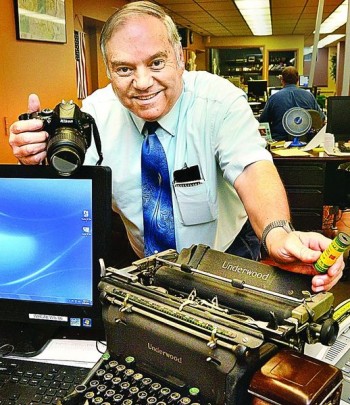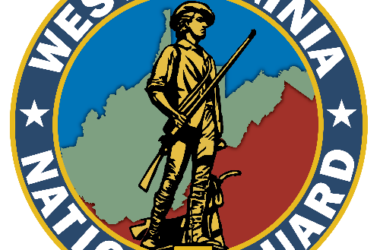
Retiring newspaperman Art Limann poses with the old and new technology he used during his 43 years in the business.
WHEELING, W.Va. — When Art Limann began his photojournalism career 43 years ago, there were no computers, digital cameras or spell check – unless you picked up a dictionary. There were, however, typewriters, a darkroom full of chemicals and smoking in the newsroom.
Limann, a New Jersey native, retired Saturday from his career with The Intelligencer and Wheeling News-Register, marking the end of a career that got its start during the Kent State University shootings on May 4, 1970.
As a student at Kent State, Limann’s career gained a foothold via photographs he took on that fateful day when National Guardsmen fired on students protesting the Vietnam War at his college campus, killing four.
It’s a day he will never forget and one that launched him head-first into a career behind the lens chronicling the events that shape the Ohio Valley.
Limann said the events at Kent State remain clear in his memory.
“I was going to walk across the campus when the shooting started. I ran back to get my camera and started taking pictures. I ended up developing the film in my bathroom at home because they closed down the school. … The whole thing was surreal,” Limann said.
While Limann took some photography courses in college, his love of journalism blossomed in Wheeling.
“I was hired in August 1971 by Harry Hamm, editor of the News-Register,” Limann explained. “I got my degree in journalism/public relations but I was told working at a newspaper would give me the experience I needed to decide if I wanted to do public relations or newspaper work.”
Limann sat behind a manual typewriter to pound out stories for the first year at the newspapers only to turn his attention fulltime to photography when the opportunity presented itself.
He recalled one of his first beats was to cover happenings at the Federal Building in Wheeling. He often stopped in to talk with the U.S. Army recruiters located in the building. That’s where a recruiter sold him his first 35mm camera outfit that the soldier had purchased in Japan.
“It was a Canon and it cost me $200 with all the accessories. That’s when I started taking pictures to go with my stories,” Limann said.
Limann worked with editors such as George Contos and Al Molnar, and writers Don Daniels, Kitty Doepken and Gladys and Bill Van Horne. He said they each did their best to encourage him in his reporting career. He recalls taking obituaries over the phone while the AP and UPI news tickers clacked away in the newsroom.
Yet Limann’s passion, he soon learned, was taking pictures. An unfortunate accident at a crime scene landed head photographer Don Muhleman in surgery and put Limann smack in the darkroom while Muhleman recovered.
Later, another opportunity developed that allowed Limann to work solely as a photographer to handle photo assignments and accompany reporters to take photographs for their stories.
“I liked my job. I really enjoyed the excitement, going out meeting people,” Limann said. His work earned a number of first-place photography awards from the West Virginia Press Association.
His most notable photo that turned up in newspapers around the world was taken on the Fort Henry Bridge. The photo showed a Wheeling firefighter rescuing a truck driver from the wrecked cab of his tractor trailer as it teetered over the side of the bridge above the Ohio River.
“I got clippings from Germany, Canada, Australia, and all around the country on that one,” he recalled.
Limann said for every enjoyable assignment, there were more than his share of difficult tasks as a news photographer. He remembers taking pictures of a funeral service in Wheeling for five fire victims that included a mother and her children.
“I stood across the street from the Cathedral and took pictures. Some people were upset I was there. I tried to explain that I was not a ghoul, that I was taking the pictures so the community could mourn with them, to share in their grief,” Limann said.
It was always the fatal fires and accidents that stuck with Limann long after the film dried. He took pictures at a fire in Barton where three children died. “That was so hard. It turns out I knew the family from church. I sent the photo on the (Associated Press) wire and they paid me for it. I couldn’t take the money. I gave it to the church for the funeral expenses.”
On the brighter side of his career, Limann said he enjoyed assignments that included taking pictures of Phil Niekro when Niekro visited his ailing father at Wheeling Hospital. Niekro presented his father the baseball he used when he won his 300th game while with the New York Yankees. Limann ended up with his own autographed baseball from Niekro that day.
Limann has snapped photos of four presidents including Ronald Reagan at Oglebay Park, Jimmy Carter in Steubenville, Gerald Ford at Bethany and George W. Bush in Wheeling. He said many celebrities have been in his viewfinder including a young Brad Paisley. His trips to sporting events far and wide throughout the Ohio Valley also garnered photo awards and praise from his co-workers.
“Art Limann, for more than four decades, has been the consummate community journalist, chronicling the life and times of those living in the Upper Ohio Valley,” John McCabe, the newspapers’ managing editor, said. “Whether roaming the sidelines of a high school football game or knee-deep in flood water, Limann always did his best to provide local residents with an accurate accounting of that day’s events. He is a professional who did his job well, and we wish him all the best in the future.”
“Newspaper work is demanding. For more than 40 years, though, Art Limann has managed to do it while also contributing to his community through programs such as the Boy Scouts and being involved in his church,” Executive Editor J. Michael Myer added. “At the same time, family always comes first for Art – as it should. What has impressed me most about him is his idea of perfectionism in doing his best to get a job done the right way. We’ll miss him – but we wish him and his family well.”
Limann also has visited many of the secret corners of Wheeling that few get to see.
“I’ve been in the basements and on the rooftops of a lot of buildings in this city,” Limann said. “I even went up in a plane to get some shots of W.Va. 2 and ended up spotting a structure fire, calling 911 and watching until the firetrucks arrived.”
Limann has witnessed, through his lens, the construction of the Intermodal Transportation Center and Cabela’s at The Highlands, among others, and the destruction of dozens of buildings and bridges. His work allowed him some unusual and rewarding experiences including using a bow and arrow to shoot a carp on Captina Creek.
He said when computers came into the newsroom, “spell check saved me.”
“We thought color film was a big deal when we began using it. Now there is no more film or darkroom. Everything is digital. If someone had told me when I started here that someday we would be taking pictures without film I would have said they were crazy,” Limann said,
In retirement, Limann is looking forward to traveling and fishing. He and his wife, Sue, plan to visit their children and grandchildren.
“I really enjoyed many of the feature stories I wrote and the pictures I took along the way. I got to meet a lot of really good and interesting people,” he said.
To read more from The Intelligencer/Wheeling News-Register, subscribe here.






